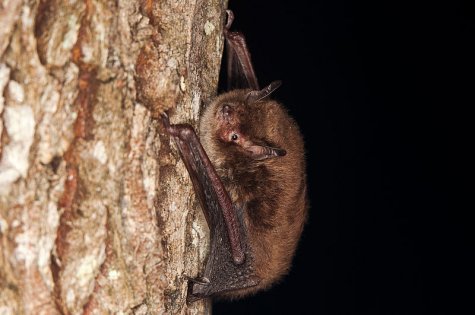Continuing the introduction of the “hand-winged”
Text: Triinu Tõrv, MTÜ Suurkõrv / http://nahkhiired.blogspot.com/
Photos: Malin Tverin and Rauno Kalda
Photos: Malin Tverin and Rauno Kalda
Daubenton’s bat Veelendlane Myotis daubentonii
The Daubenton’s bat belongs to the genus Myotis: The greatest number of species of Estonian bats belong to this genus, five of them. The most common of them is today’s subject, the Daubenton’s bat. It is a medium sized bat with wings with a span of up to 27 centimetres and a weight of around 10 grams. The Daubenton’s bat’s fur is light brown, the underbelly is clearly lighter than the back. The flight membranes are also pale brown. The face is often pinkish and particularly the pink hairless eye surroundings are striking.
The Daubenton’s bat’s flight is even and its favourite places are water bodies.—If you should notice some very low-circling bats that from time to time touch the water surface in summer above a water body it will very probably be Daubenton’s bats.
The pond bat (Myotis dasycneme), a little larger than the Daubenton’s bat, hunts in the same way but it is much less spread than the Daubenton’s bat. The Daubenton’s bat has particularly large foot soles that are useful in the hunt. Aided by the hind feet and the tail membrane it can create something like a landing net to catch insects that appear on the water surface. Sometimes the Daubenton’s bat can even catch an unsuspecting fish but the greater part of its diet consists of insects. Breeding colonies of Daubenton’s bats are mainly in tree hollows although in Europe stone bridges and abandoned limestone buildings serve as shelters for them.
The typical echo location impulse of the Myotis bats looks like a standing stick on the spectrogram. It means that individual sound impulses are very short but cover a large range of sound frequencies. Above water the Daubenton’s bat is easy to identify but when it happens to fly among trees it is quite complicated to separate it from the other Myotis bats only by sound. To hear the Daubenton’s bat the heterodyne detector must be set at 40 kHz, then listen carefully. Their echo location calls are not particularly loud. The best listening frequency of the similarly-looking pond bat is a little lower, at 35 kHz, and the sound in the detector is more smacking and uneven than the uniform crackle of the Daubenton’s bat.
The Daubenton’s bat is a stationary and quite common species. They stay with us for wintering. As wintering localities humid underground spaces are suited, with a suitable temperature during the whole winter, - 5 - 7 °C. Ordinary small cellars are often either too dry or too cold for Daubenton’s bats. Large ice cellars are more suitable. Large numbers of Daubenton’s bats hibernate in the big hibernating spots in Estonia such as at Piusa caves or the long tunnels of the sea defence works of Peter the Great. It is however not allowed to go there in winter to look at bats because the large wintering localities are protected by law and during the hibernation period of bats entering there is prohibited. In matters tied to large wintering localities the Environmental Board can be contacted.










